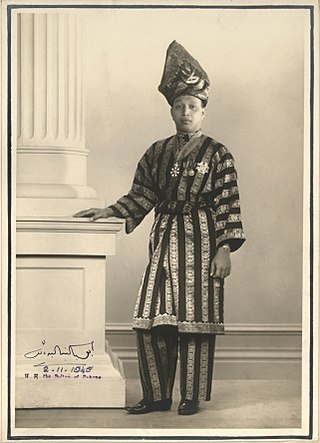
The Malay College Kuala Kangsar is a residential school in Malaysia. It is an all-boys and all-Malay school in the royal town of Kuala Kangsar, Perak. It is sometimes dubbed "the Eton College of the East".

Sultan Abu Bakar Ri’ayatuddin Al-Mu’azzam Shah Ibni Al-Marhum Sultan Abdullah Al-Mu’tassim Billah Shah, was the fourth modern Sultan of Pahang.

The Kuala Kangsar is the royal town of Perak, Malaysia. It is located at the downstream of Kangsar River where it joins the Perak River, approximately 25 km (16 mi) northwest of Ipoh, Perak's capital, and 98 km (61 mi) southeast of George Town, Penang. It is the main town in the administrative district of Kuala Kangsar, about 235 km from Kuala Lumpur, Malaysia. The town is administered by the Kuala Kangsar Municipal Council, formerly known as Kuala Kangsar District Council from 1 January 1980 until 17 February 2004.

Taiping is a town located in Larut, Matang and Selama District, Perak, Malaysia. It is located approximately 48 km (30 mi) northwest of Ipoh, the capital of Perak, and 78 km (48 mi) southeast of George Town, Penang. With a population of 245,182, it is the second largest town in Perak after Ipoh, the state capital.
The Federal Route 1 is the first federal road in Malaysia, the oldest federal road in Malaysia, and among the nation's earliest public roadways ever constructed. The Federal Route 1 was the backbone of the road system in the western states of Peninsular Malaysia before being supplanted by the North–South Expressway.
Federal Route 5 is one of the three north–south oriented backbone federal roads running along the west coast of Peninsular Malaysia, Malaysia. The 655.85 kilometres (408 mi) federal highway runs from Jelapang, Perak in the north to Skudai, Johor in the south.
Sultan Yussuf Izzuddin Shah Ibni Almarhum Sultan Abdul Jalil Karamatullah Nasiruddin Mukhataram Shah Radziallah Hu'an-hu, KCMG OBE was the 32nd Sultan of Perak, whilst it was a part of the Federation of Malaya.

Khoo Kay Kim was a Malaysian historian and academic of Chinese descent. He was honoured with Emeritus Professor title by the University of Malaya in 2001. In January 2011, Khoo was appointed Chancellor of KDU University College.

The Perak River is the second longest river in Peninsular Malaysia after Pahang River in Pahang, Malaysia.

Karai is a small town in Mukim Kota Lama Kanan, Kuala Kangsar District, Perak, Malaysia. The town is also called Enggor. The town grew due to the coal industry.

Sultan Sir Idris Murshidul Azzam Shah Ibni Almarhum Raja Bendahara Alang Iskandar Marhum Teja was the 28th Sultan of Perak. Perak at that time was part of the British-administered Federated Malay States.
Iskandariah Bridge or Sultan Iskandar Bridge is one of four major bridges in Kuala Kangsar, Perak, Malaysia with the other one being the Sultan Abdul Jalil Shah Bridge. The 308-meter bridge crosses the Perak River near the town and is made out of steel.

The Sultan Abdul Jalil Shah Bridge is one of two bridges that cross the Perak River in Kuala Kangsar, Perak in Malaysia. The other bridge is the Iskandariah Bridge.

Sultan Azlan Muhibbuddin Shah ibni Almarhum Sultan Yussuff Izzuddin Shah Ghafarullahu-lah was Sultan of Perak from 1984 until his death in 2014, and the ninth Yang di-Pertuan Agong, from 1989 to 1994.

Nazirul Naim bin Che Hashim is a Malaysian professional footballer who plays for Malaysia Super League club Kuala Lumpur City as a left-back.

The Guillemard Bridge is a single track railway truss bridge located in Kusial, Tanah Merah District, Kelantan, Malaysia. It is the second-oldest railway bridge in the country after Victoria Bridge in Perak, although unlike Victoria Bridge, this bridge is still in use today.

Arthur Benison Hubback was British Army officer and architect who designed several important buildings in British Malaya, in both Indo-Saracenic architecture and European "Wrenaissance" styles. Major works credited to him include Kuala Lumpur railway station, Ubudiah Mosque, Jamek Mosque, National Textile Museum, Panggung Bandaraya DBKL, Ipoh railway station, and Kowloon railway station.

Kuala Terengganu Drawbridge is a bascule bridge located in Kuala Terengganu, Terengganu, Malaysia, and crosses the mouth of Terengganu River. It is the fourth bridge within the Kuala Terengganu City area that straddles the river after Sultan Mahmud Bridge, Manir Bridge, and Pulau Sekati Bridge.
Ahmad Kamil bin Jaafar was a Malaysian politician and diplomat.
Tan Sri Mazlan Nordin was a Malaysian journalist. He was a journalist at Utusan Melayu and Berita Harian; Editor-in-Chief and managing director of Utusan Melayu (1983–1987). Then first Chief Editor and chairman of the Malaysian National News Agency (BERNAMA) from February 1989 until 2003.

















